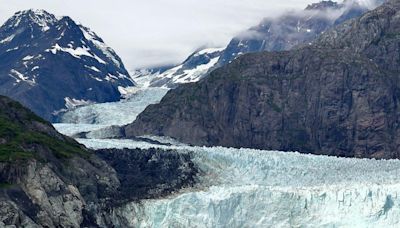Search results
Jul 8, 2024 · With over 700 miles of trails, Glacier is a paradise for adventurous visitors seeking wilderness steeped in human history. Relive the days of old through historic chalets, lodges, and the famous Going-to-the-Sun Road.
A glacier ( US: / ˈɡleɪʃər /; UK: / ˈɡlæsiər, ˈɡleɪsiər /) is a persistent body of dense ice that is constantly moving downhill under its own weight. A glacier forms where the accumulation of snow exceeds its ablation over many years, often centuries.
Jul 2, 2024 · glacier, any large mass of perennial ice that originates on land by the recrystallization of snow or other forms of solid precipitation and that shows evidence of past or present flow.
Oct 19, 2023 · Glaciers are masses of snow that has been compressed into giant sheets of ice. Most glaciers were formed during the last ice age. Glaciers are massive bodies of slowly moving ice. Glaciers form on land, and they are made up of fallen snow that gets compressed into ice over many centuries.
A glacier is an accumulation of ice and snow that slowly flows over land. Alpine glaciers are frozen rivers of ice, slowly flowing under their own weight down mountainsides and into valleys. Ice sheets exist only on Greenland and Antarctica, and they spread out in broad domes in multiple directions.
A glacier is a large, perennial accumulation of crystalline ice, snow, rock, sediment, and often liquid water that originates on land and moves down slope under the influence of its own weight and gravity.
- geology.com
- › General Geology
What is a Glacier? A glacier is a slowly flowing mass of ice with incredible erosive capabilities. Valley glaciers (also known as alpine glaciers or mountain glaciers) excel at sculpting mountains into jagged ridges, peaks, and deep U-shaped valleys as these highly erosive rivers of ice progress down mountainous slopes.
Oct 19, 2023 · Glaciers are large bodies of ice that move over Earth’s surface. A glacier is formed as snow accumulates over time and turns to ice, a process that can take more than a hundred years. Once a glacier has formed, it moves very slowly, at a rate of years, or even decades; some glaciers are frozen solid and do not move at all.
Glacial landform, any product of flowing ice and meltwater. Such landforms are being produced today in glaciated areas, such as Greenland, Antarctica, and many of the world’s higher mountain ranges. In addition, large expansions of present-day glaciers have recurred during the course of Earth.
Jun 20, 2024 · Lake McDonald - 1. To many visitors to the park, this view is their first introduction to the spectacular scenery of Glacier National Park. This iconic view from Apgar, at the foot of Lake McDonald, really shows what Glacier is all about...big glacially carved lakes, vast wild views of the high peaks along the Continental Divide, and the ever ...

